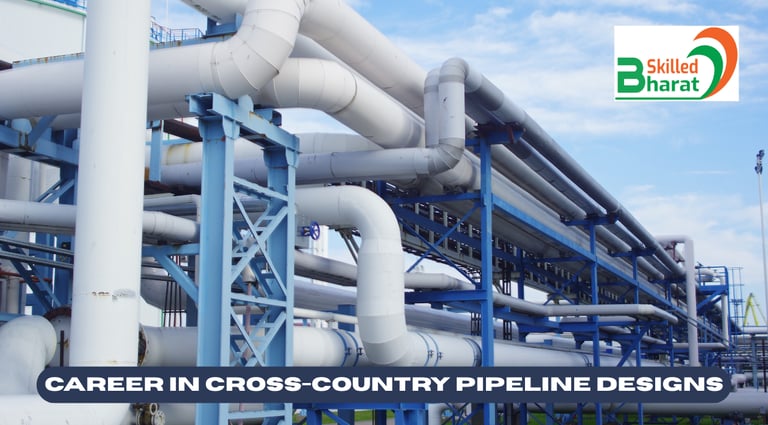Cross-Country Pipeline Design
Requirements, Software, Courses, Fees, and Job Opportunities
4/30/20254 min read


Cross-country pipeline design is a specialized field in engineering, critical for transporting oil, gas, water, or other fluids over long distances. These pipelines connect production facilities to refineries, storage terminals, or distribution networks, requiring robust design to ensure safety, efficiency, and environmental compliance. This blog explores the requirements, software tools, training courses, associated fees, and job opportunities in cross-country pipeline design.
What is Cross-Country Pipeline Design?
Cross-country pipeline design involves creating systems to transport fluids across vast distances, often spanning hundreds or thousands of kilometers. Key considerations include:
Route Selection: Optimizing the pipeline path to minimize environmental impact, terrain challenges, and costs.
Material Selection: Choosing corrosion-resistant materials to withstand fluid properties and external conditions.
Hydraulic Analysis: Ensuring adequate flow rates and pressure management.
Structural Integrity: Designing pipelines to handle thermal expansion, seismic activity, and soil loads.
Regulatory Compliance: Adhering to standards like ASME B31.4 (liquid pipelines), ASME B31.8 (gas pipelines), API 1104, and local regulations.
The design process includes route surveys, hydraulic simulations, stress analysis, and environmental impact assessments.
Requirements for Cross-Country Pipeline Design
Professionals in this field need:
Educational Background: A bachelor’s degree in mechanical, civil, chemical, or petroleum engineering.
Technical Skills:
Knowledge of pipeline codes and standards (ASME B31.4, B31.8, API 1104, CSA Z662).
Expertise in hydraulic modeling, stress analysis, and geotechnical engineering.
Understanding of corrosion protection, welding, and pipeline integrity management.
Familiarity with geographic information systems (GIS) for route planning.
Software Proficiency: Proficiency in pipeline design and analysis software (see below).
Soft Skills: Problem-solving, project management, and communication for coordinating with multidisciplinary teams and stakeholders.
Certifications: Credentials like API 1169 (Pipeline Construction Inspector) or ASME B31 certification enhance employability.
Popular Software for Cross-Country Pipeline Design
Several software tools are used for designing and analyzing cross-country pipelines:
AutoPIPE (Bentley):
Used for pipeline stress analysis under thermal, pressure, and soil loads.
Features: Compliance with ASME B31.4/B31.8, dynamic analysis.
Cost: ~$4,000–$8,000 per license.
CAESAR II (Hexagon):
Industry-standard for static and dynamic stress analysis.
Features: Pipeline flexibility, support design, and seismic analysis.
Cost: ~$5,000–$10,000 per license.
Aspen HYSYS (AspenTech):
Supports hydraulic modeling and flow assurance in pipeline design.
Features: Multiphase flow simulation, pressure drop calculations.
Cost: ~$10,000–$20,000 per license.
ArcGIS (Esri):
Used for route selection and environmental impact analysis.
Features: Terrain mapping, land use analysis, and GIS data integration.
Cost: ~$1,500–$7,000 per license.
Synergi Pipeline Simulator (DNV):
Specialized for pipeline hydraulics and transient analysis.
Features: Leak detection, flow optimization, and real-time monitoring.
Cost: ~$8,000–$15,000 per license.
PIPE-FLO (Engineered Software):
Cost-effective for hydraulic and flow analysis.
Features: Pipeline network modeling and pump sizing.
Cost: ~$2,000–$5,000.
Note: Costs are approximate and vary by region, licensing model, and add-ons. Many vendors offer training with software purchases.
Courses for Cross-Country Pipeline Design
Training is essential for mastering pipeline design. Below are popular courses and providers:
Online Courses:
Udemy: “Pipeline Design and Engineering” or “CAESAR II for Pipeline Stress Analysis.”
Duration: 5–15 hours.
Fee: $20–$150 (frequent discounts).
Coursera/EdX: Courses on fluid mechanics or GIS with pipeline applications.
Duration: 4–8 weeks.
Fee: Free (audit) or $50–$200 (certificate).
Piping Design Online: Specialized courses on pipeline design, AutoPIPE, and hydraulic modeling.
Duration: 20–40 hours.
Fee: $200–$600.
Classroom/On-Site Training:
Hexagon (CAESAR II Training):
Duration: 3–5 days.
Fee: $1,500–$3,000 per participant.
Locations: Houston, Calgary, Dubai, etc.
Bentley Institute (AutoPIPE Training):
Duration: 2–4 days.
Fee: $1,000–$2,500.
ASTS Global Education:
Offers pipeline engineering diplomas with modules on design and stress analysis.
Duration: 3–6 months.
Fee: $1,000–$4,000 (online or in-person).
Certifications:
API 1169 Pipeline Construction Inspector: ~$1,000–$2,000 (exam + prep course).
ASME B31.4/B31.8 Pipeline Design: ~$500–$1,200.
NACE CP1 (Corrosion Protection): ~$1,500–$3,000.
Tip: Look for employer-sponsored training or group discounts. Software vendors often provide free webinars or introductory courses.
Job Opportunities in Cross-Country Pipeline Design
Pipeline design engineers are in demand across energy and infrastructure sectors. Key points:
Roles:
Pipeline Design Engineer: Develops pipeline layouts, performs hydraulic and stress analysis.
Pipeline Project Engineer: Oversees design, procurement, and construction phases.
Corrosion Engineer: Designs cathodic protection systems for pipelines.
GIS Analyst: Supports route planning and environmental assessments.
Industries:
Oil and Gas (crude oil, natural gas, LNG pipelines).
Water and Wastewater (transmission pipelines).
Renewable Energy (hydrogen, CO2 pipelines).
Mining (slurry pipelines).
Salary:
Entry-Level: $60,000–$85,000/year (US), ₹5–10 LPA (India).
Mid-Level: $85,000–$130,000/year (US), ₹10–20 LPA (India).
Senior-Level: $130,000–$180,000+/year (US), ₹20–40 LPA (India).
Salaries vary by location, experience, and project complexity.
Job Outlook:
Strong demand due to global energy needs and infrastructure development.
Growth in renewable energy pipelines (e.g., hydrogen, carbon capture) creates new opportunities.
Freelance/consulting roles are viable with certifications and experience.
Top Employers:
EPC firms: Fluor, Bechtel, Saipem, TechnipFMC.
Pipeline operators: TC Energy, Enbridge, Kinder Morgan.
Consultancies: Worley, Jacobs, DNV.
How to Get Hired:
Build a portfolio showcasing CAESAR II, AutoPIPE, or ArcGIS projects.
Network on LinkedIn or attend industry events (e.g., API or ASME conferences).
Gain experience through internships or junior roles in pipeline design or construction.
Conclusion
Cross-country pipeline design is a dynamic and rewarding career, combining engineering expertise with environmental and regulatory considerations. With the right education, software skills, and certifications, engineers can thrive in this field. Affordable online courses and vendor-provided training make entry accessible, while expertise in tools like CAESAR II, AutoPIPE, or ArcGIS enhances employability. As global demand for energy and sustainable infrastructure grows, job opportunities in pipeline design remain robust, offering competitive salaries and career growth.
